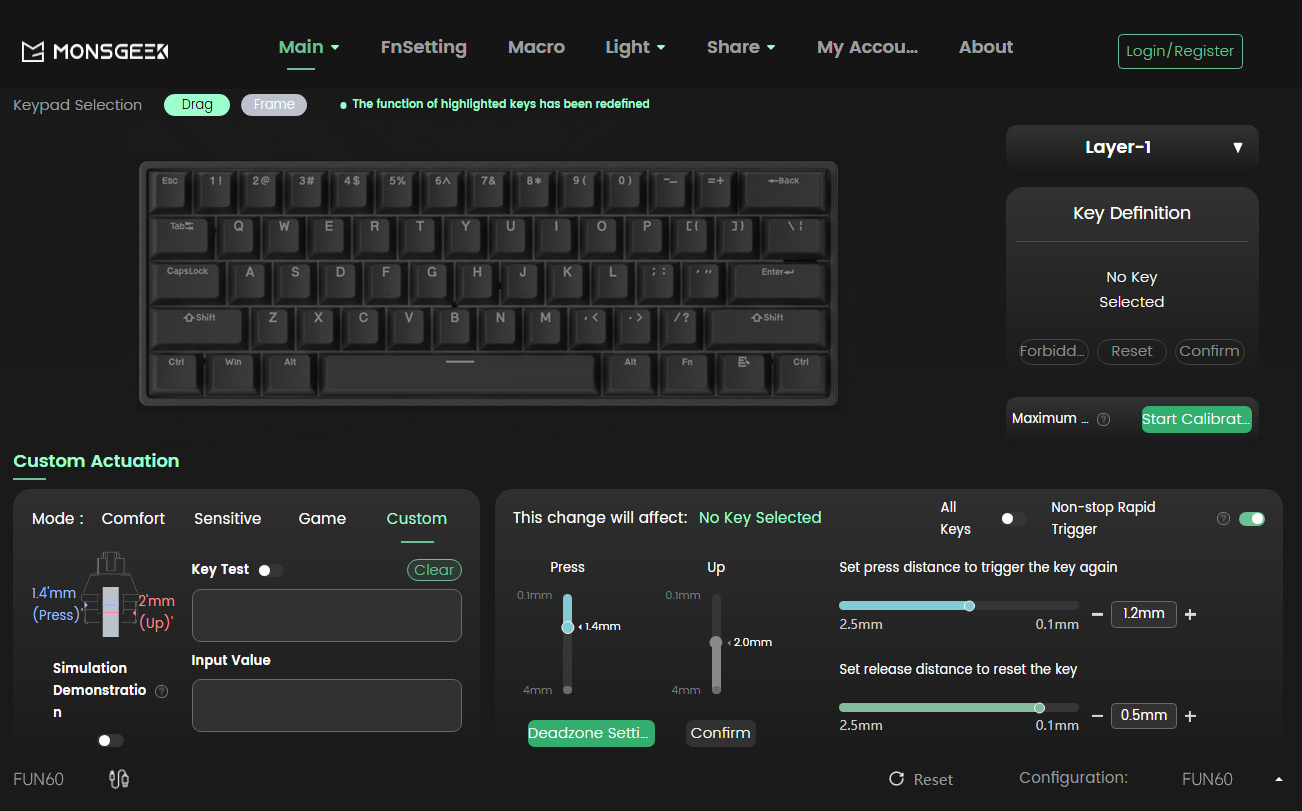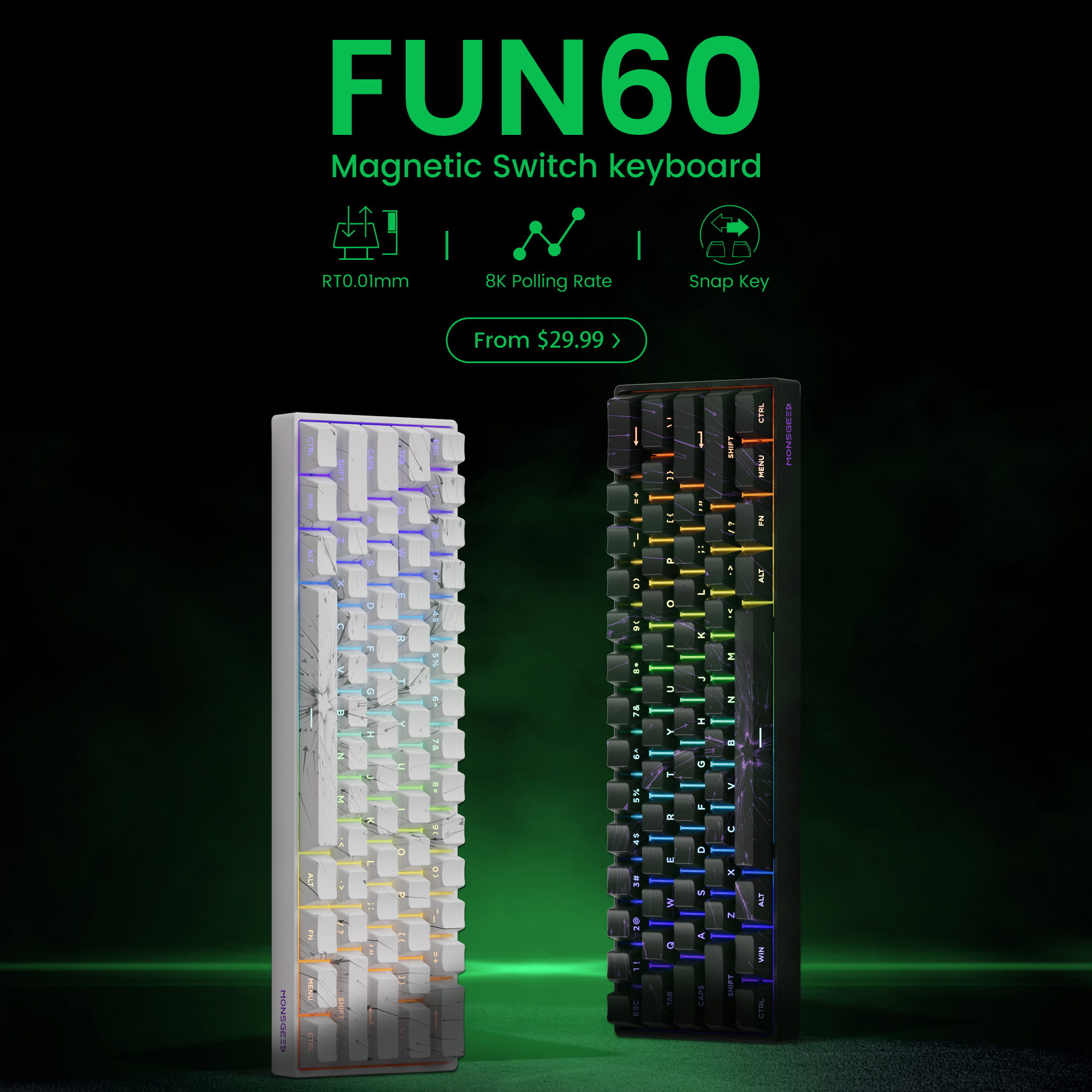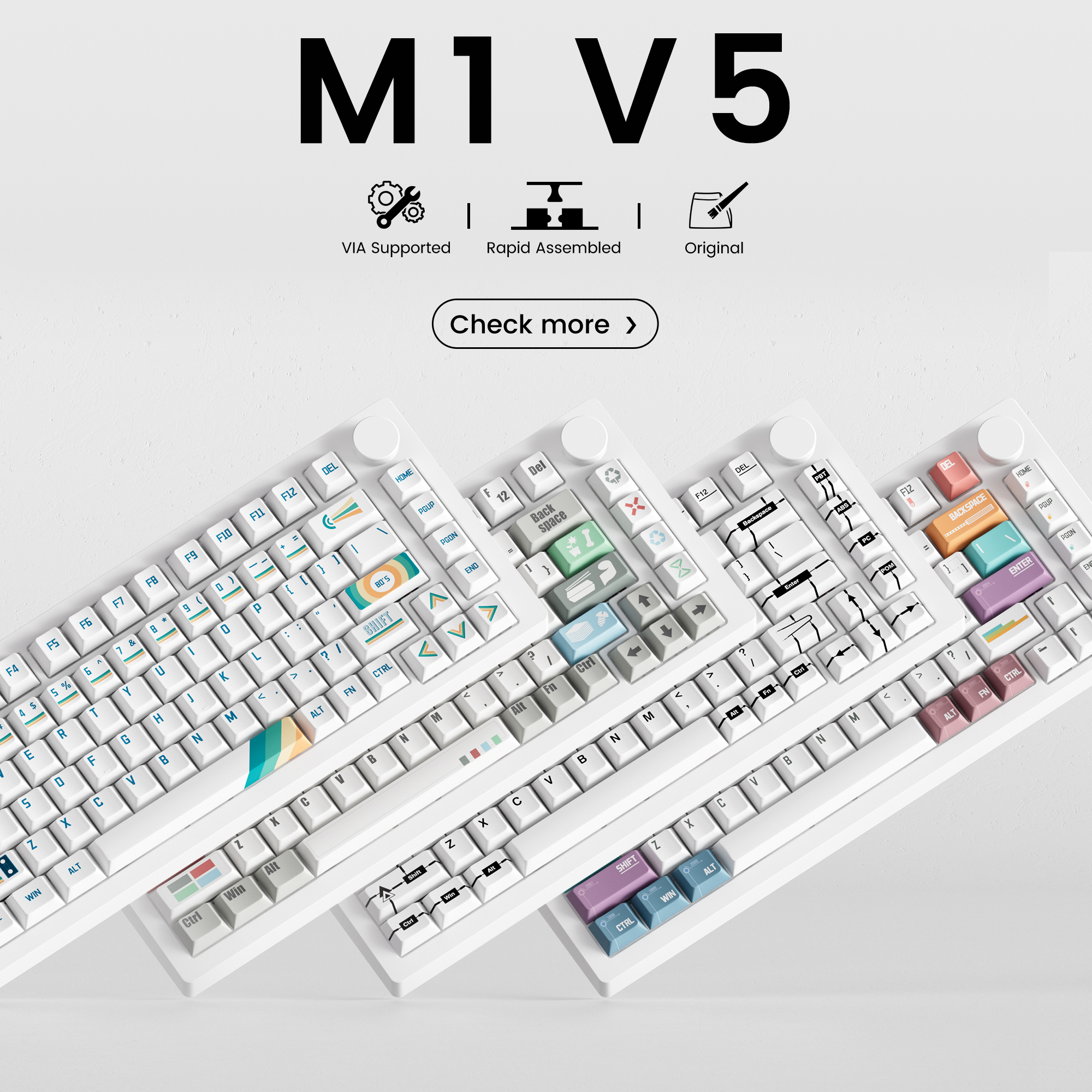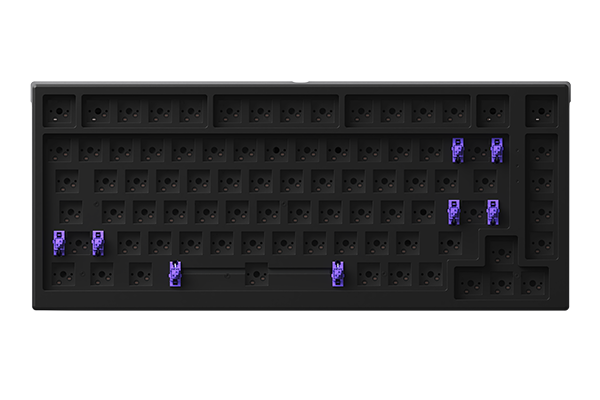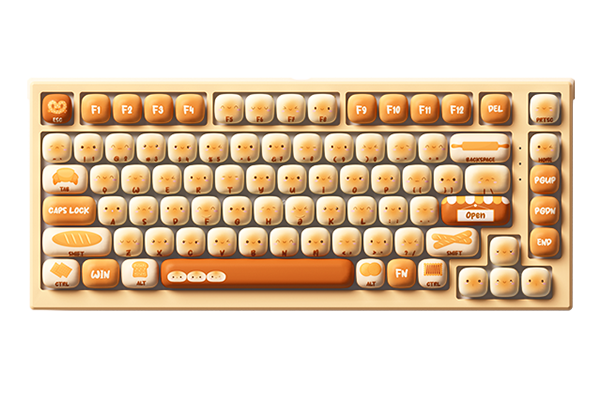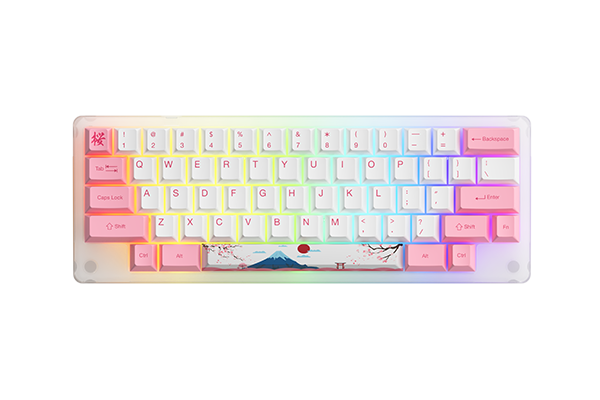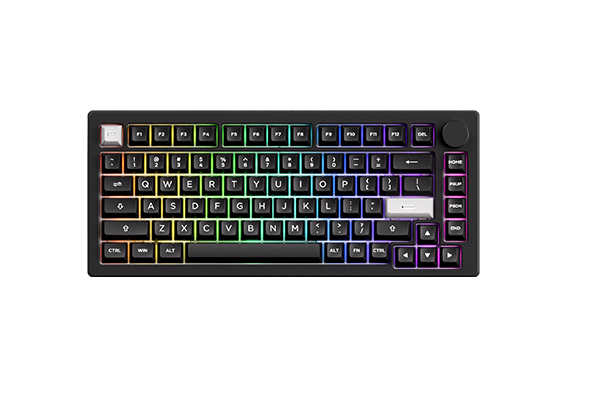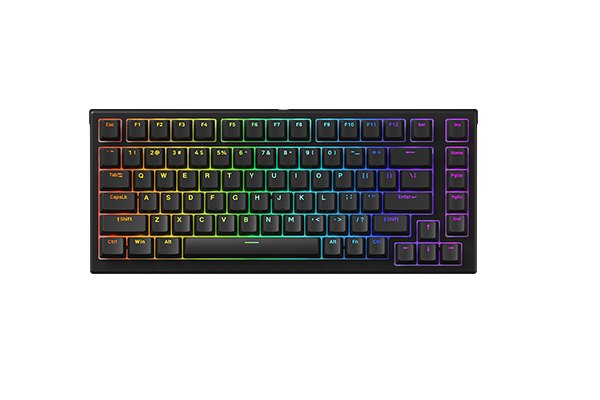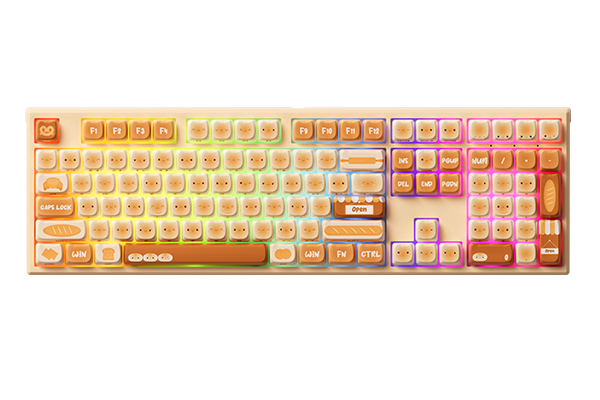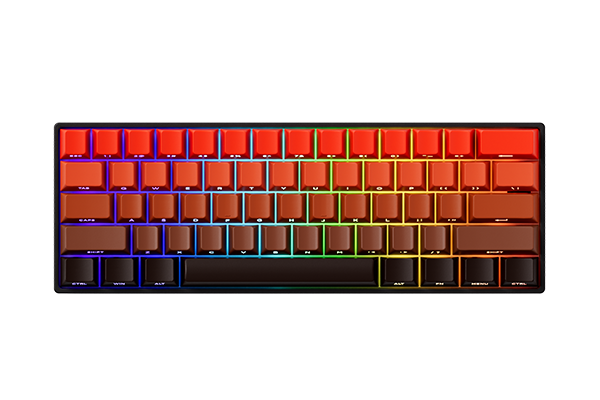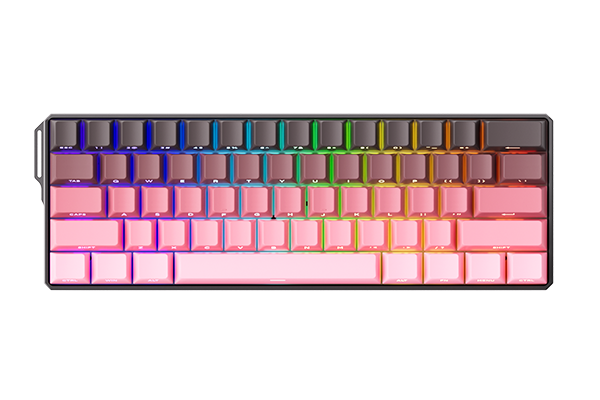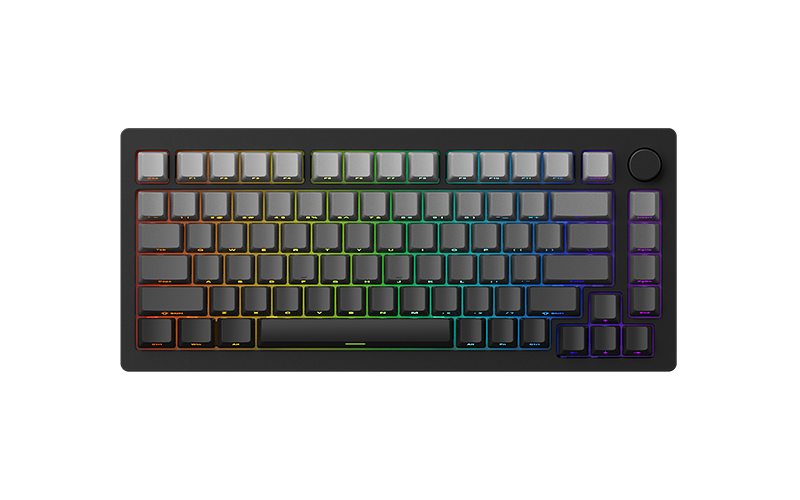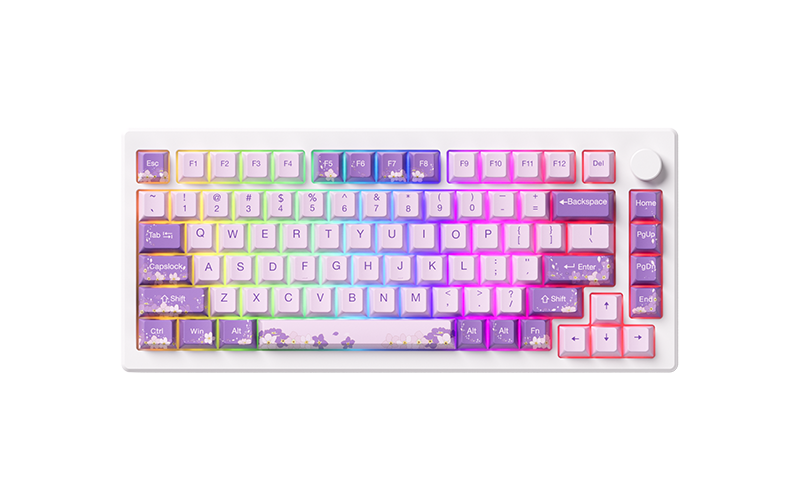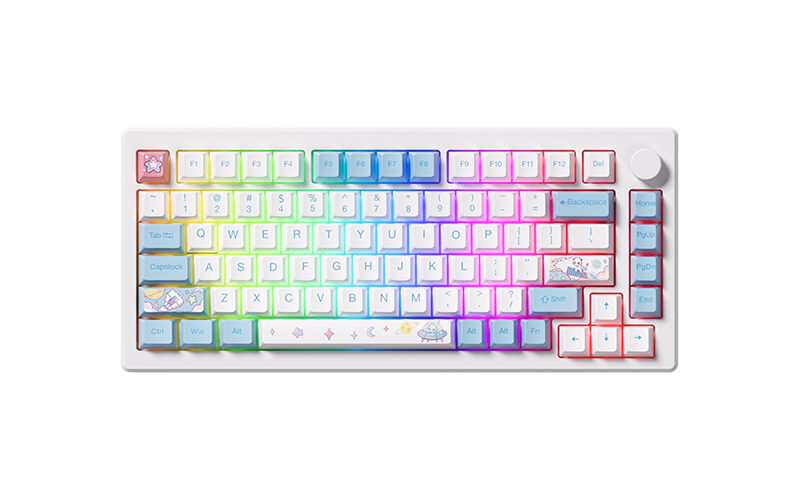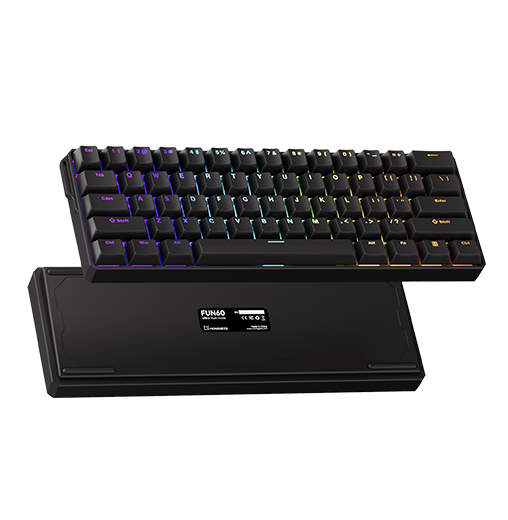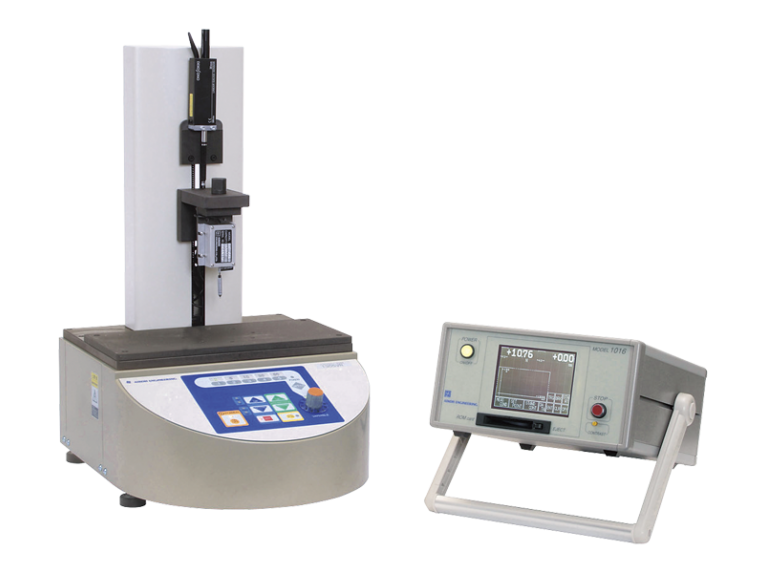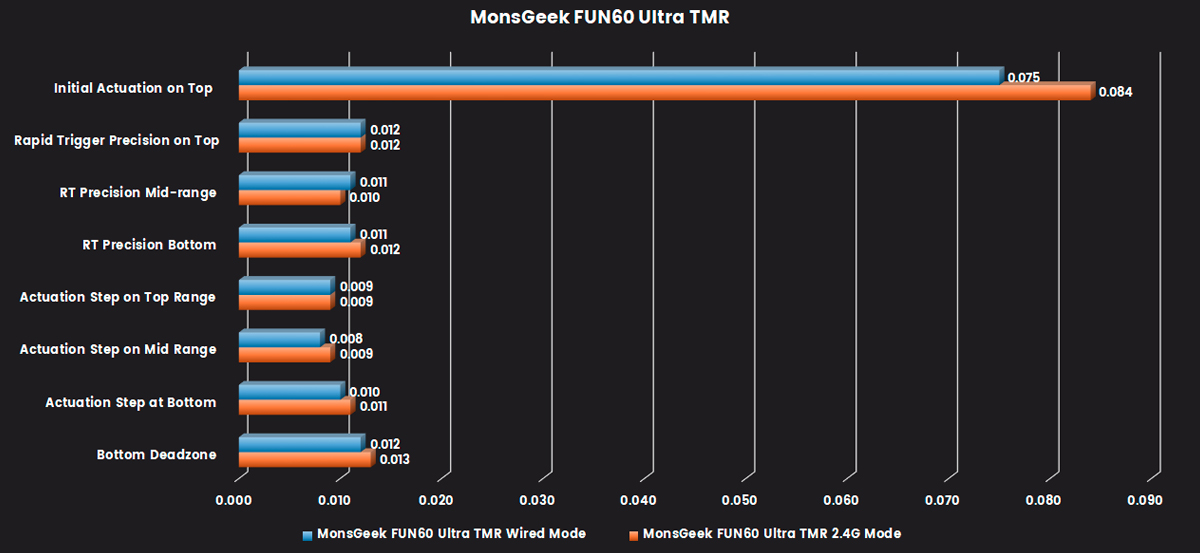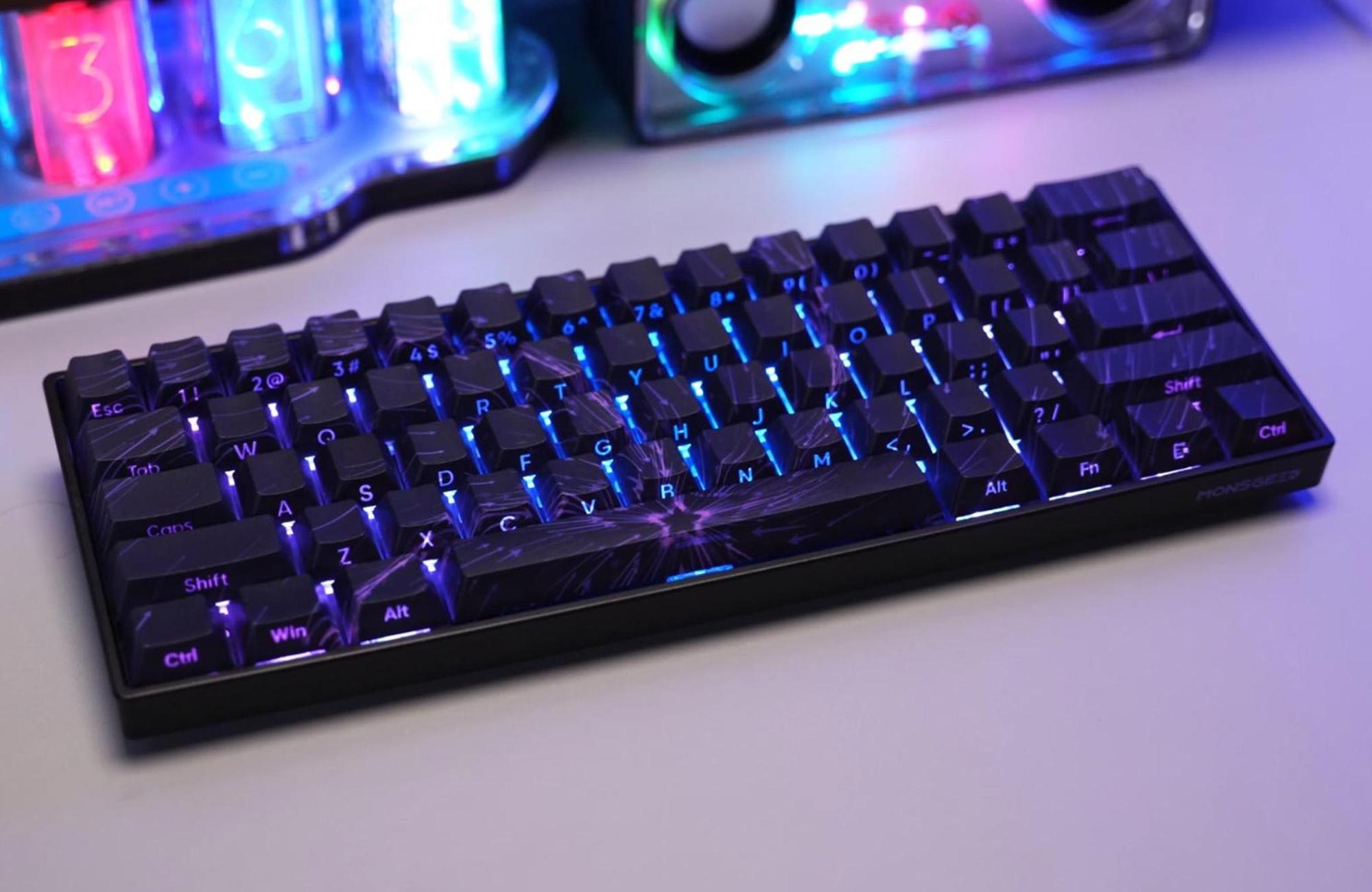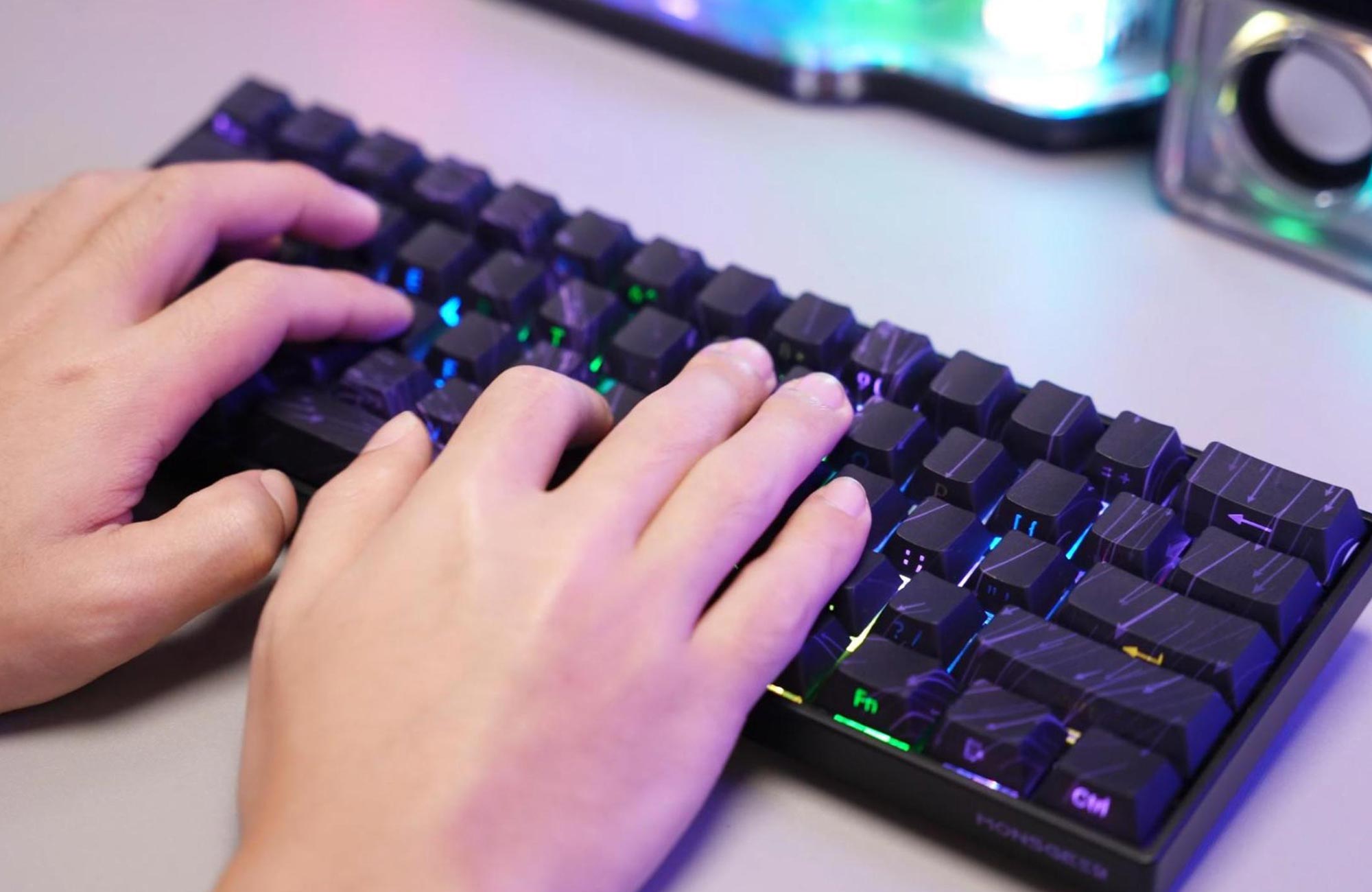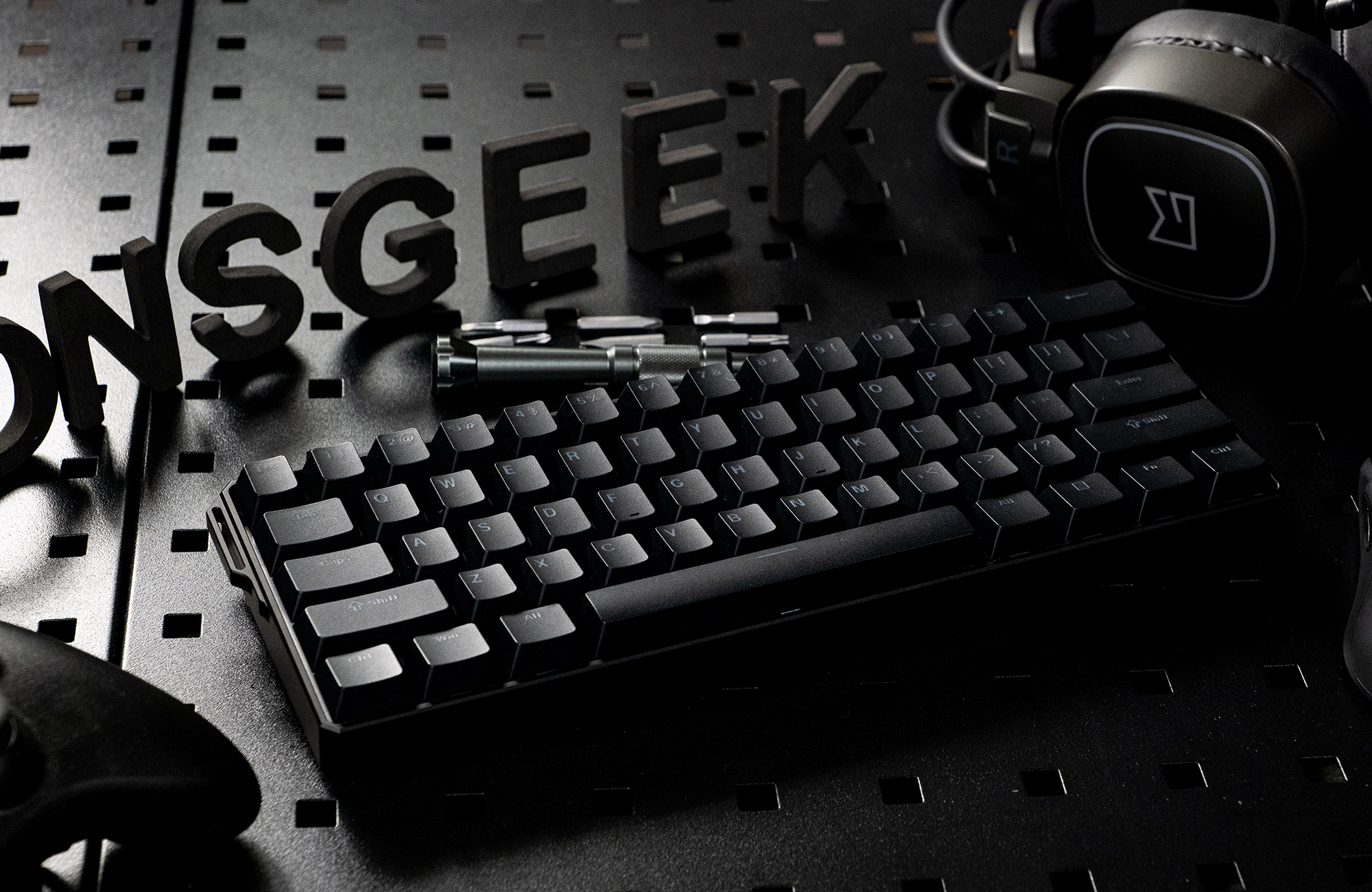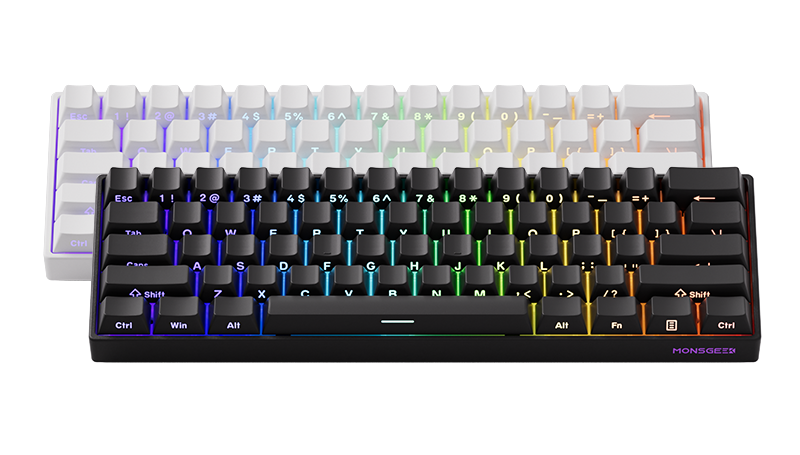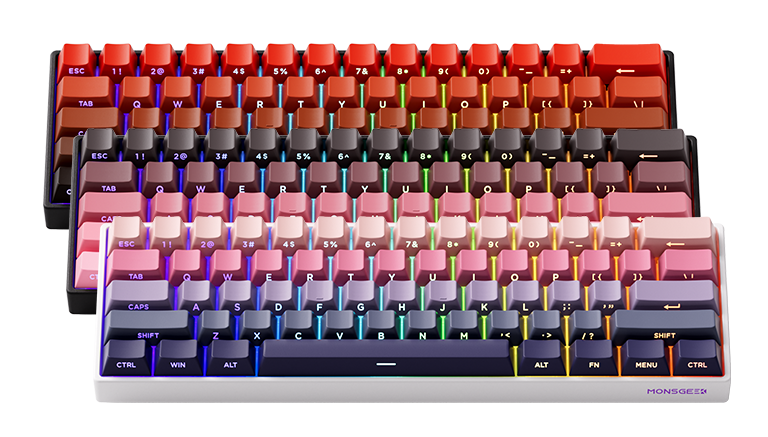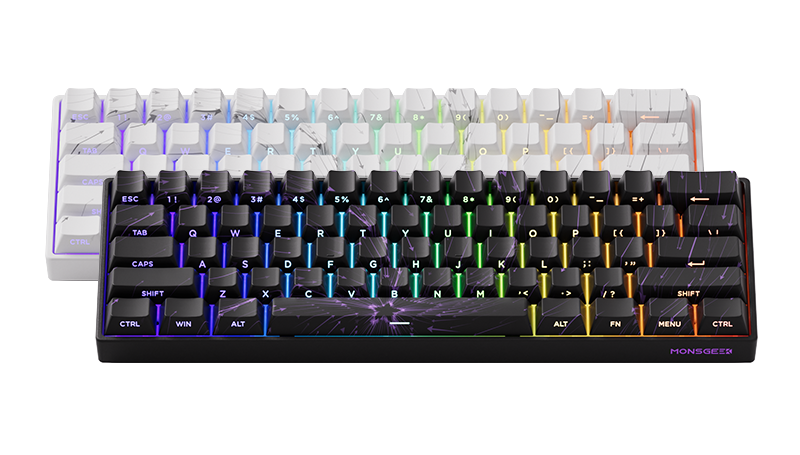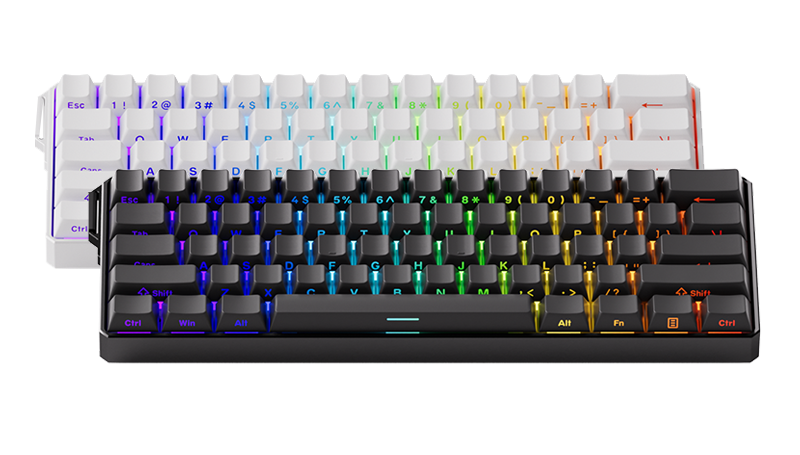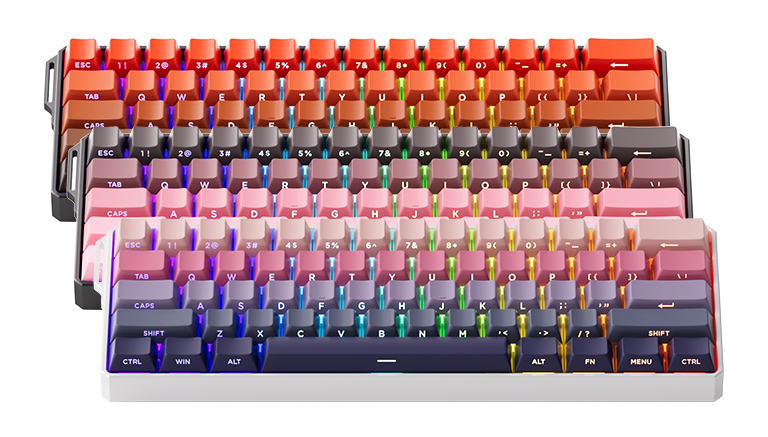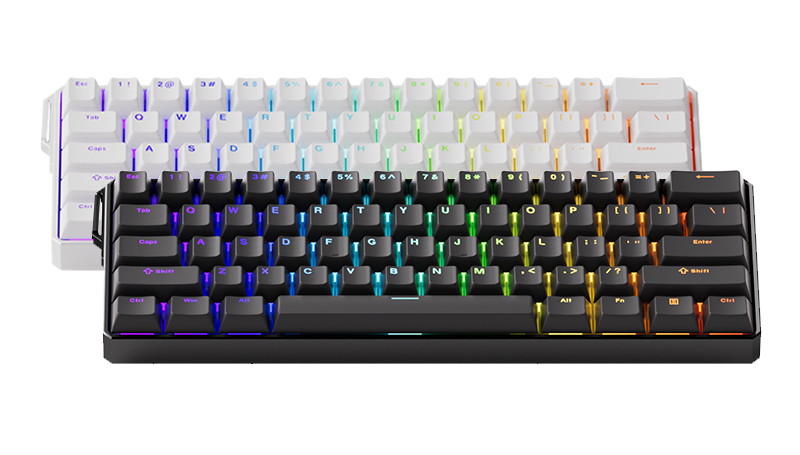The Evolution of LED Technology in Keyboards: The Newest ARGB
📅Jan 20 2025
LED lighting has significantly changed the mechanical keyboard landscape. What began as a simple feature has grown into a customizable and dynamic element that enhances both function and aesthetics.
Let’s explore the different stages in LED development.
1. Non-LED Keyboards: The Basics
Early mechanical keyboards were simple and functional, focusing on performance without any lighting. While practical and budget-friendly, they lacked backlighting, making them less ideal for typing or gaming in low-light conditions especially at night.
Worthy of mention, some users prefer to choose this series of keyboards for three reasons:
• Some enthusiasts believe LEDs affect the keyboard’s sound, so they prefer LED-free
• Others think LEDs are unnecessary and prefer no lighting for a minimalist look
• In some gaming scenarios, LEDs must be turned off during overclocking
2. Single White LED: Basic Illumination
The introduction of single white LED backlighting was a game-changer in the past, allowing keyboards to be used in low-light settings. While the lighting was limited to one color, it made typing easier in the dark and gave the keyboard a cleaner, more modern look.
My Melody 3108v3
3. Pre-set Rainbow LED Color: A Burst of Color
After the introduction of single white lighting, LEDs with pre-set rainbow colors were added. While users couldn’t choose individual key colors, these Rainbow colors allowed the keyboard’s lighting to match the setup or mood, creating a more dynamic and visually appealing experience.
ACR59 World Tour Tokyo
4. Customizable RGB: Total Control
Customizable RGB lighting took things further, letting users adjust brightness, colors, and effects for each key or zone through QMK/VIA or third-party software.
It offers flexibility to match preferences, moods, or setups, enhancing both aesthetics and functionality.
With Dynamic RGB, the lighting reacts to key presses or system events, adding interactivity and immersion.
This level of control was especially popular among gamers, who could create unique color profiles for different games or applications.
*Generally RGB keyboards use individual LEDs for each key, allowing color and brightness adjustments. By mixing red, green, and blue, these LEDs can produce millions of color.
5. ARGB (Addressable RGB): Customizable and Flicker-Free
ARGB stands for Addressable RGB, allowing individual control of each LED’s color and brightness. It offers greater precision and customization, making it perfect for unique and vibrant lighting setups.
The main feature of ARGB is flicker-free lighting, which ensures smooth and stable lighting without visible flickering. This helps reduce eye strain and visual fatigue, especially during long use.
The FUN60 Magnetic Switch is our first keyboard to use ARGB. With Alpha channel integration and a 500Hz refresh rate, it delivers richer dynamic effects and reduces visual fatigue, making it ideal for gaming and aesthetic builds.
From the simplicity of non-LED keyboards to today’s vibrant ARGB effects, LED technology has greatly improved both the functionality and visual appeal of mechanical keyboards. Whether for gaming or typing, LED lighting plays a key role in design.
As technology evolves, what will the next upgrade be?
Why we removed Roar Mode from FUN60?
📅Jan 02 2025
You may have heard about the concept of “Roar Mode” when we release our first HE keyboard, the MonsGeek M1W HE.
And yet this feature is removed from FUN60. And we will explain why.
What is Roar Mode and how does it work?
Roar Mode is essentially a Turbo mode that is designed to optimize your keyboard’s responsiveness by BOOSTING the scan rate of selected 4 keys at a cost of other keys.
Note here we talk about scan rate NOT polling rate. The polling rate of the keyboard is fixed for 8K on all keys and cannot be adjusted, regardless of whether you turned on Roar mode or not.
And the latency of the keyboard is closely relevant to both concepts.
By boosting the scan rate, Roar Mode improves the latency of the 4 fixed keys, providing a more immediate reaction during gaming or intensive typing sessions. They were often set to WASD.

For example, on the M1W V3 HE Magnetic Switch Keyboard, Roar Mode can be applied to keys like WASD, with each key automatically boosting its scan rate to 10K. This enhancement would be beneficial for gaming and according to our user feedback, is quite noticeable on the 4 selected keys.
The good thing is. It helps gaming. But the bad thing is, it is only limited to 4 keys. And yet the responsiveness of other keys will be slower than non-Roar mode. You may not even notice the responsiveness of keys during regular typing events, but in competitive gaming, maybe you need more than 4 keys?

It would be ideal if the ROAR MODE can be extended to more keys.
And here comes the “Dynamic Roar Mode” concept on FUN60.
FUN60 Series with built-in “Dynamic Roar Mode”
With its new ARM chip and updated algorithm, the FUN60 Series introduces Dynamic Roar Mode, which automatically boosts the performance of the last 8 keys you press (with the latest firmware upgrade) at a 16K scan rate. The last 8 keys are memorized by the device and will maintain at the boosted scan rate.
The algorithm uses a maximum boost ratio of 1:2, applied on top of the keyboard’s universal scan rate of 8K for the FUN60.
This configuration has been optimized for gaming, providing the capability to maintain turbo status for up to 8 keys simultaneously.
You might wonder: what about the other keys?
While it’s true that other keys will experience a relatively slower scan rate, this adjustment is designed to be imperceptible during regular typing, even in scenarios where more than 8 keys are used frequently.
In competitive gaming, however, most scenarios require repetitive use of up to 6 keys. This is where the Dynamic Roar Mode truly shines, ensuring faster response times and improved control.
Other Information
Theoretically MonsGeek/Akko team has the technical capability to further enhance the dynamic scan rate (e.g., 32K, 48K, or higher) for a few selected keys. However, implementing such changes would:
- Significantly increase power consumption in wireless mode.
- Further sacrifice other keys during typing events so that the lags become noticeable, resulting in bad experiences.
As a result, we decided not to pursue this option.
The keyboard also features a 32K sampling rate, which is vital for achieving 0.01mm precision. This precision requires processing large amounts of data to ensure accurate input. However, it is important to note that the 32K sampling rate does not play a significant role in reducing latency and should not be confused with the scan rate.
Additional Note
Please be aware that MonsGeek does NOT have a 32K scan rate (either in dynamic or universal). Please avoid directly translating content from flyers in our Tmall store, as language barriers may cause confusion or misinterpretation. 扫描采样率 = Sampling Rate NOT scan rate.
MagMech: Switch between Magnetic Switches and Mechanical Switches Freely
📅Dec 28 2024
If you’ve been following our FUN60 Series keyboards, you’ve likely noticed MagMech—a distinctive feature exclusive to our FUN60 Ultra TMR Version magnetic switch keyboards. But what exactly does MagMech mean, and what benefits does it bring?
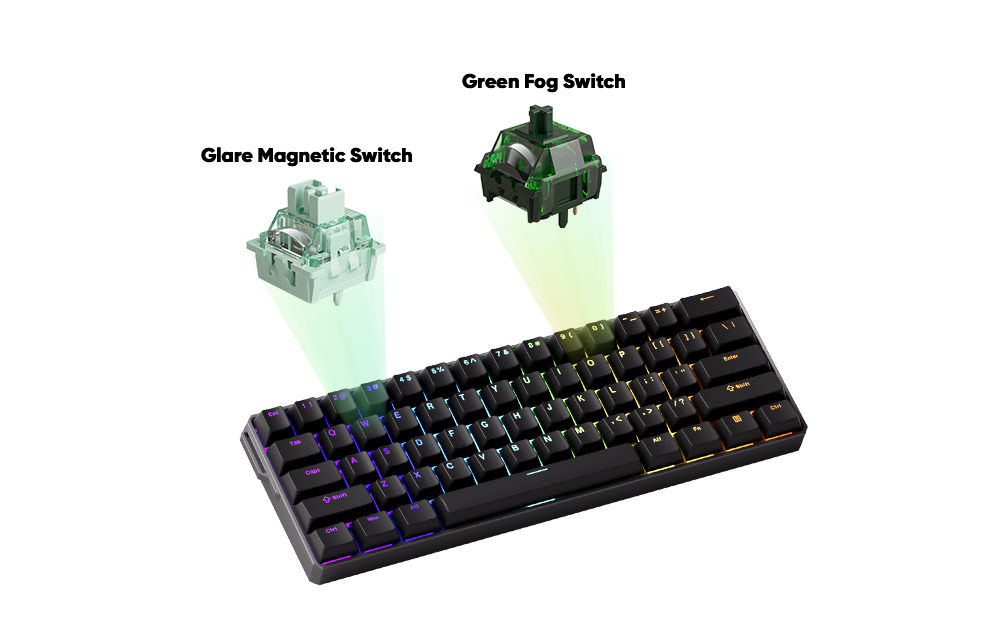
MagMech stands for Magnetic + Mechanical, and it refers to a keyboard that is compatible with both Magnetic and Mechanical switches. Some of you may have already experienced customization options on the MonsGeek M1 HE Wired or MOD007 Hall Effect Keyboard. However, these were limited to 3-pin mechanical switches only.
Now, with the NEW FUN60 Ultra TMR Keyboard, we bring you the ultimate customization experience. This Aluminum Magnetic Switch Keyboard not only supports 3-pin switches but also ANY 5-pin mechanical switches, offering you greater flexibility.
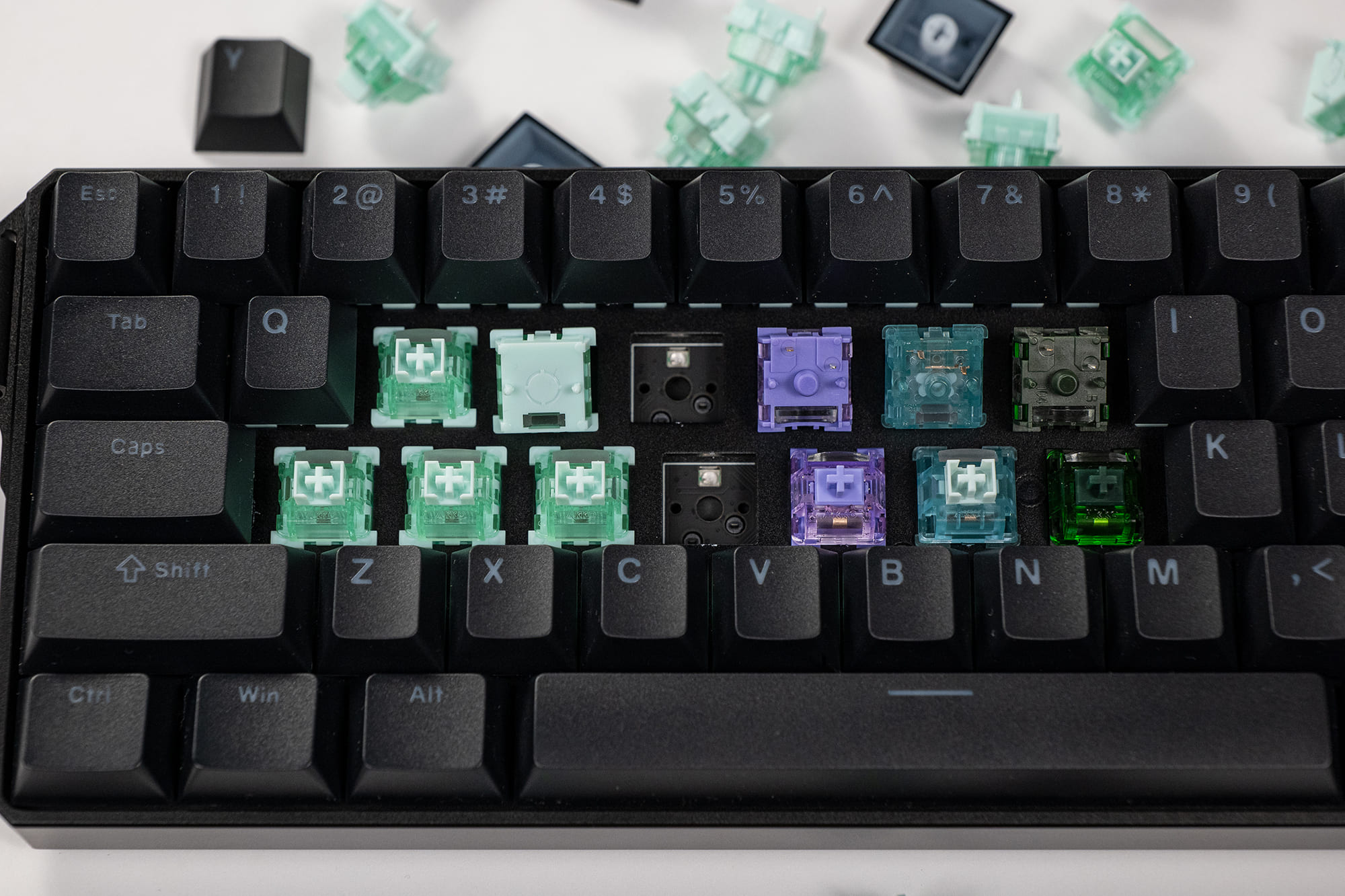
*Note:OUTEMU Half-height Switches are not supported
Imagining having only WASD / Arrow keys swapped for magnetic switches, and leave the rest for mechanical for a classic mechanical typing experience. What a dream!
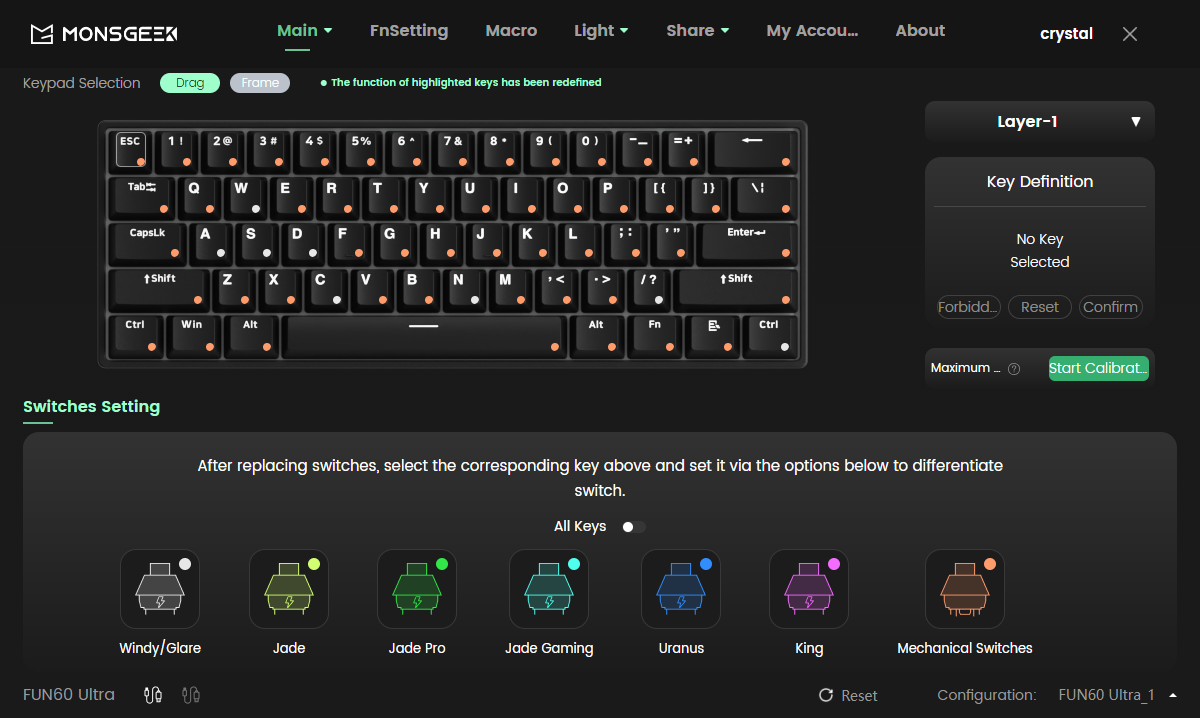
What’s more, the FUN60 Ultra TMR offers a wireless version, which offers strong flexibility to manage multiple devices at the same time.
*Sound test of Green Fog Mechanical Switches on the FUN60 Ultra TMR version.
TMR vs. Hall Effect: Applications in Magnetic Switch Keyboards Explained
📅Dec 25 2024
When it comes to TMR, gamers familiar with joysticks will likely recognize the concept.
TMR (Tunneling Magnetoresistance) has been widely used in gaming controllers for quite some time and is now making its way into gaming keyboards. It is designed to deliver even more precise accuracy than what the Hall Effect can achieve.
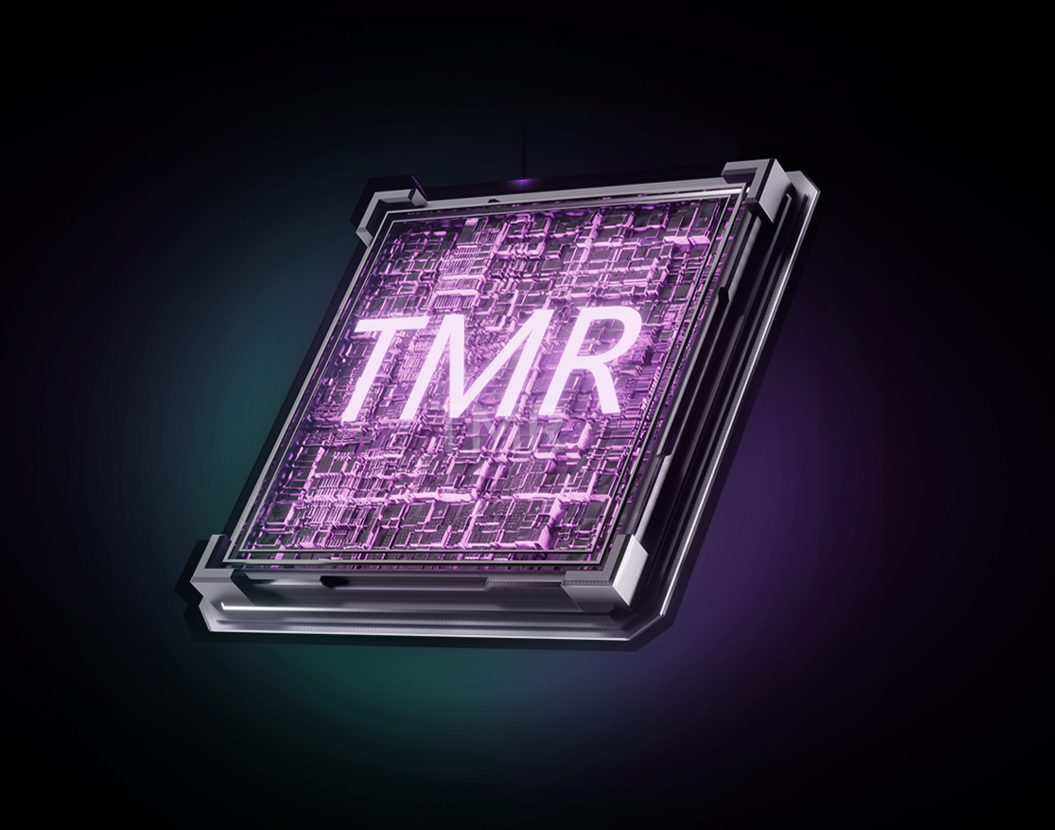
That’s exactly why TMR is integrated into magnetic switches keyboards: 1) to boost the precision, and 2) to ensure enhanced reliability for wireless gaming.
Let’s dive into the details!
TMR stands for tunnel magnetoresistance. The Hall Effect and Tunneling Magnetoresistance (TMR) are both phenomena used in sensing technologies, especially in the context of switches, such as magnetic switches used in mechanical keyboards, but they operate on different principles. The purposes of having them are to boost the actuation without having to physically touch the switches.
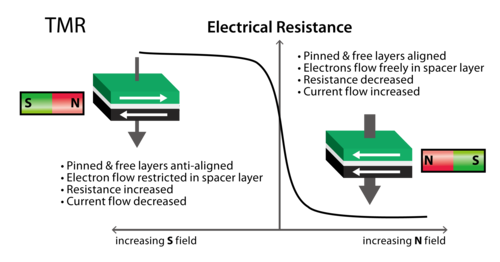
TMR is a quantum mechanical phenomenon that occurs when electrons “tunnel” through a thin insulating barrier between two ferromagnetic materials. The resistance of the material changes depending on the relative alignment of the magnetization of the two ferromagnetic layers.
A summary between TMR and Hall Effect goes into this:
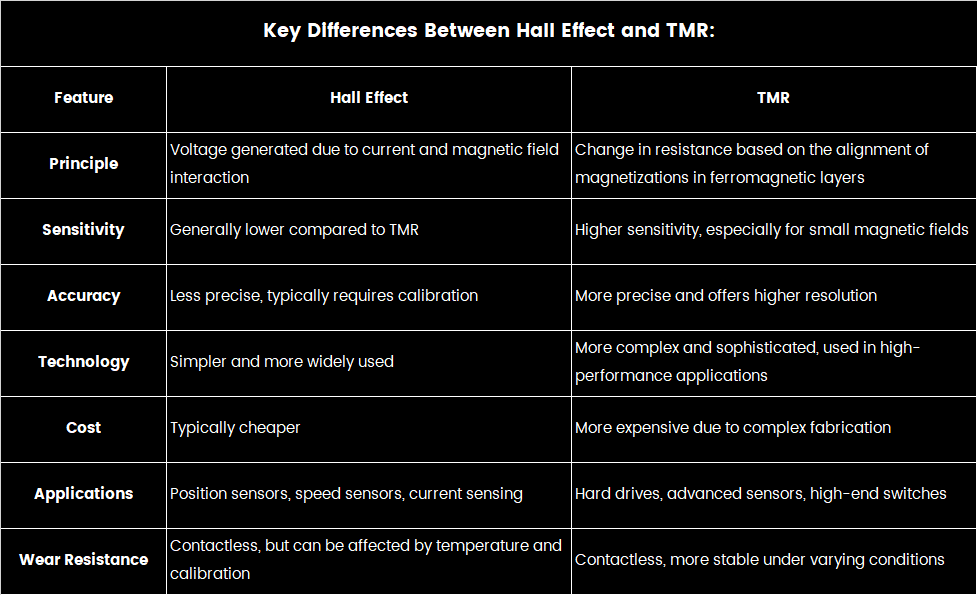
Overall, TMR offers more potential for advancing the gaming. And because it is more stable under varying conditions, it is considered to be ideal for competitive gaming in wireless conditions. It would be super cool to achieve the equivalent level of latency in wireless as in wired connection.
In 3rd party precision tests of FUN60 series, it does show that the Ultra TMR version is relatively more precise than other hall effect versions. And it is thus more expensive as well.
We would recommend the FUN60 Ultra TMR version for those seeking ultimate build quality, aiming for the MagMech feature (ensuring compatibility with mechanical switches) and also smooth experience in wireless gaming.
Is 0.01mm precision a SCAM for magnetic switches keyboard?
📅Dec 18 2024
When you first see a keyboard advertised as having a 0.01mm precision, you may ask immediately…..
“How did you achieve this?” And is this a scam?
As of today, 0.01mm precision hall effect keyboard has been comprehensively tested on Bilibili by Chinese keyboard/technology enthusiasts using different equipment. The 0.01mm precision is built in FW and chip but users would always want to validate by themselves.
To verify that, most people would purchase a force gauge tester/load tester in 0.001mm magnitude which costs from $1500 (used) to as high as $15000 or more. There isn’t a limitation of the equipment but a force gauge tester would be a reliable “ready to go” machine. If you can manage to have a DIY machine that can have an incremental movement of 0.001mm and effectively record and measure such discrepency changes, then it would work as well.
Note when we were testing for 0.1mm precision keyboard, a 0.01mm magnitude force gauge can be used used. And the below gauge from Hong Feng is the most popular one among all for testing the actual actuation point and release point. This digital gauge costs around $200 and is fairly accessible.
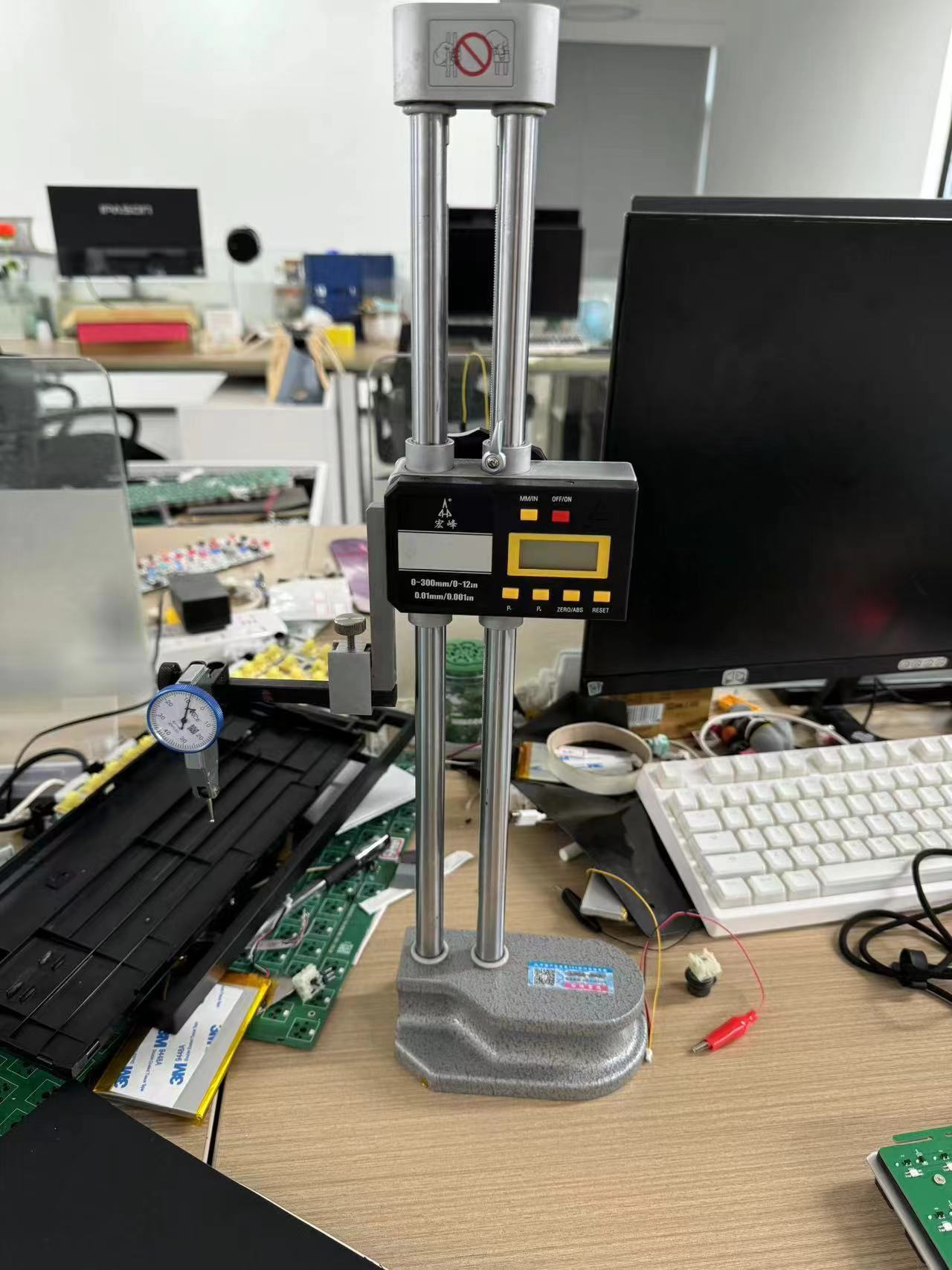
However, when it comes down to a 0.01mm precision, devices that can only measure at a magnitude of 0.01mm will be too rough to provide an accurate measurement. The needle or pressing unit of the gauge or machine that attaches to the keyboard must be able to move in increments of 0.001mm with minimal force. Apparently, the precision test would NOT work if the gauge tester requires you to directly move the needle by human hands (which can hardly control at even 0.1mm precision) or with bigger displacement movement of needle that is larger than 0.01mm.
The keyboard will be connected to the computer physically as usual. For example, if you are testing the accuracy of release point, please control the gauge to gradually move the pressing needle so that the keyboard will be pressed at the actuation point. You can set this point as 0. Then you can gradually release the load tester needle in 0.001mm increments to determine at which actuation point (in mm) the keyboard stops input and resets.
The same method can be used to test the initial actuation at 0.1mm and the deadzone.
Below are several tests by different influencers with sources:
*Source: In外设 (video at 02:05)
in外设 seems to be using 3D printer (based on the Fluidd UI for Klipper) to control movement? It is a very creative way of validating the precision.
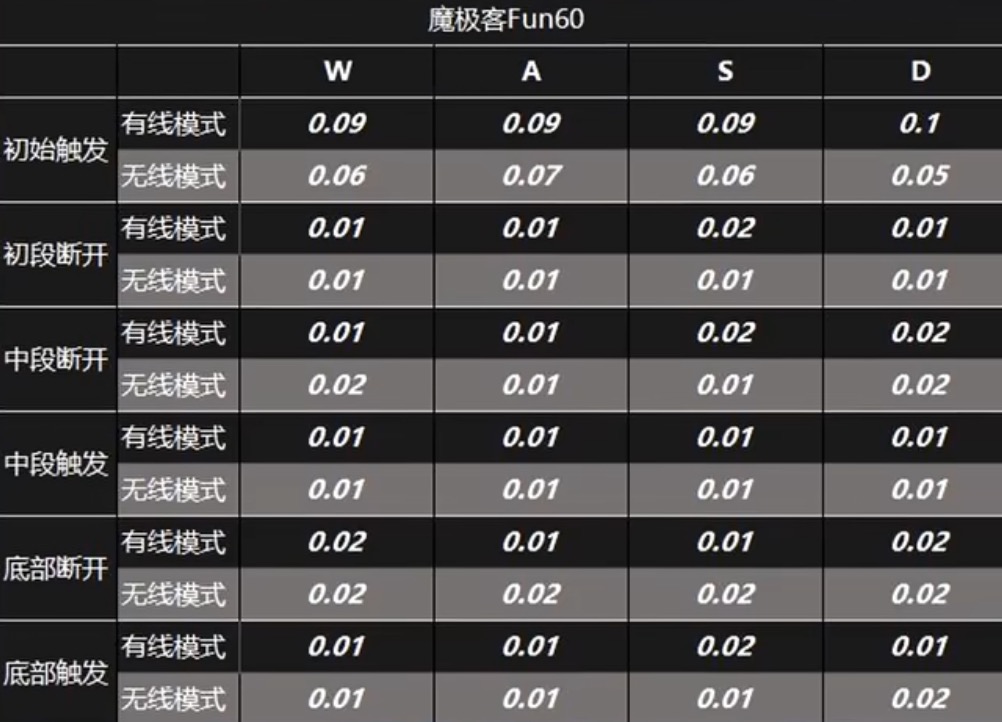
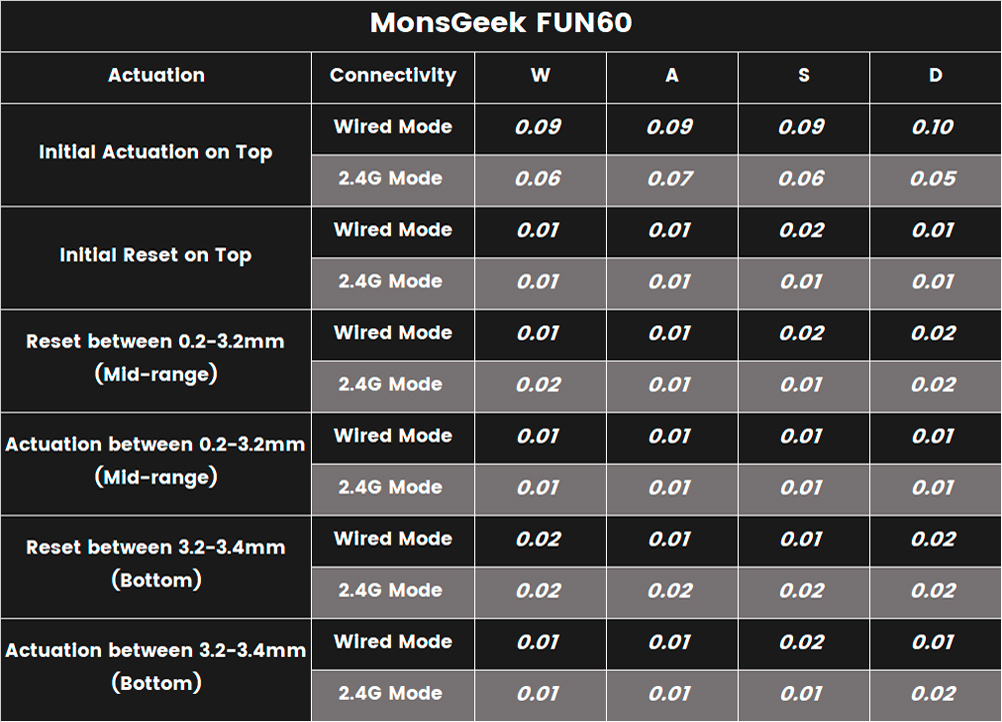
*Source: 键盘侠赤瞳妖 (video at 00:39)
AIKOH 1305VC is the equipment being used by this influencer for the test as he previously disclosed the equipment in his first 0.01mm precision test video.

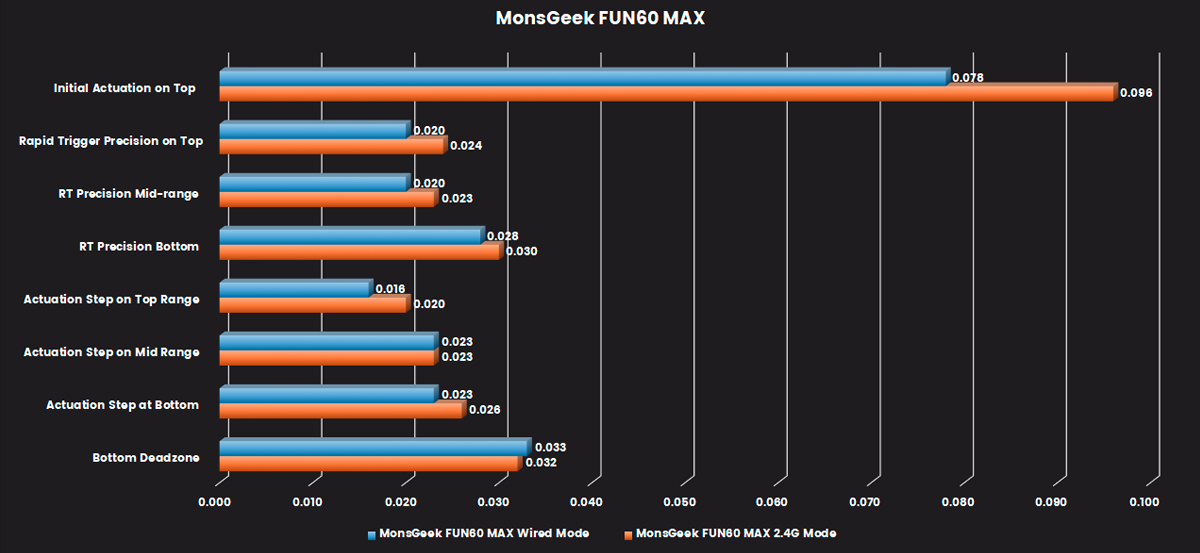
From those results, we can see the keyboard generally has better precision in actuation in wired mode.
Different machines may generate slightly different results. In this case, it is crucial to check the horizontal comparison of same machine across different keyboards (the source of the videos are disclosed, you can check if you have interests… not okay for us to talk about keebs from other brands) and even different switches can produce varying values.
We will be gradually updating the test results from new sources.
Overall most results tend to be close. 0.01mm precision is not a joke though in certain scenarios you may get 0.02mm based on the equipment and the testing environment. 0.01mm is VERY sensitive.
We have our own test for 0.01mm precision ready but we requested dev team to film the testing process soon. We would rather not post a non-3rd party graph for objectivity purposes.
It is important to note that tests are always tests. And next goes, how can we take advantage of 0.01mm precision? What is the best setting for my keyboard that can achieve high precision in competivie gaming? We will post separately.
We hope this series of articles could help you better understand FUN60 and the technology behind.
Do You Really Need 0.01mm Precision for Your Magnetic Switch Gaming Keyboard?
📅Dec 17 2024
Rule No. 1: Be Honest With Customers! We believe 0.01mm precision is SUPER COOL! But 0.1mm precision might already be more than enough to perform exceptionally well.
Do You Really Need 0.01mm?
This article may hurt sales of MonsGeek FUN60. But we want to be honest with our thoughts.
In our own testing at MonsGeek, we’ve found that most users may not notice a significant difference between 0.1mm and 0.01mm precision during typical typing or casual gaming. Even in competitive gaming scenarios, the benefits of such extreme precision are most noticeable only to highly skilled players with exceptional reflexes and heightened sensitivity.

The average human hair width ranges from 0.016 to 0.05mm. And that’s why for most people, it is something that isn’t noticeable at all.

That’s why we believe it’s important to set realistic expectations. While 0.01mm precision is an impressive leap in technology and offers exciting potential for certain gamers, it’s okay to acknowledge that 0.1mm precision might already provide everything you need for an enjoyable and competitive experience.
Therefore, if you already have a 0.1mm hall effect keyboard, you may not want to upgrade unless one of the following reasons appeals to you:
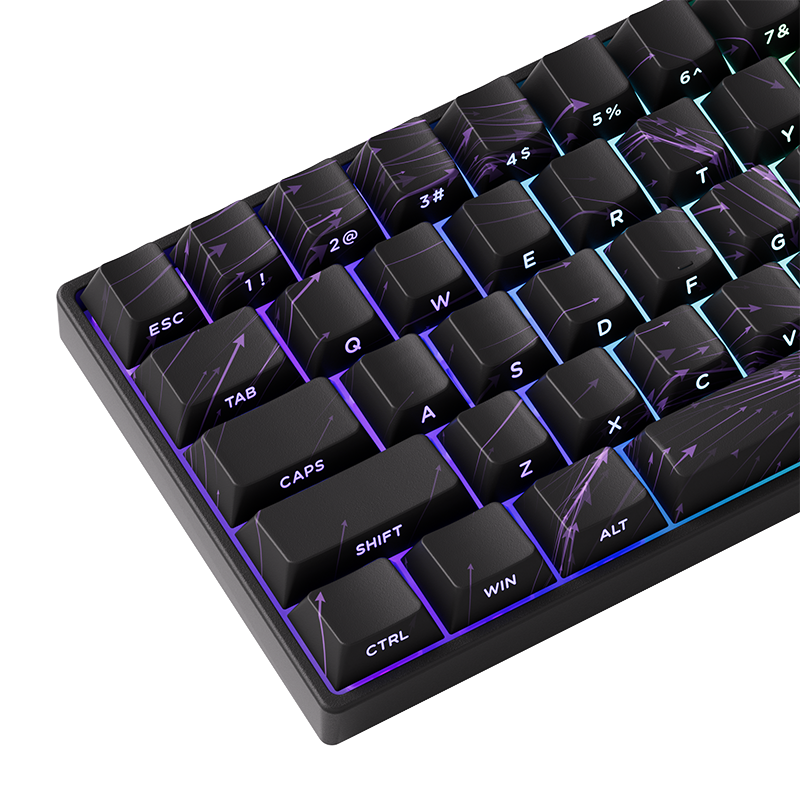
At MonsGeek, we’re committed to pushing the boundaries of innovation while ensuring that our customers understand the benefits—and the limitations—of what we offer.
Hands-On Insights: As Both Users and Creators of MonsGeek FUN60
📅Dec 17 2024
At MonsGeek, we believe in being upfront with our customers about our products and the challenges we face during development.
The FUN60 Magnetic Switch Keyboard, as a budget-friendly option, delivers great value within its price range. Although we’ve put considerable effort into enhancing the performance of its stabilizers after extensive testing, there is still room for further improvement.
Why Don’t the Sound Profile of the FUN60 Series Perform as Well as Other MonsGeek Fully Assembled Models?
Due to the thinner ABS cases and the light actuation force of magnetic switches, we found it challenging to fine-tune the stabilizers in the FUN60 Pro/Max versions of the FUN60 to meet our ideal standards. Despite applying factory lubrication and even swapping out springs in the magnetic switches to make them heavier, some limitations persist.
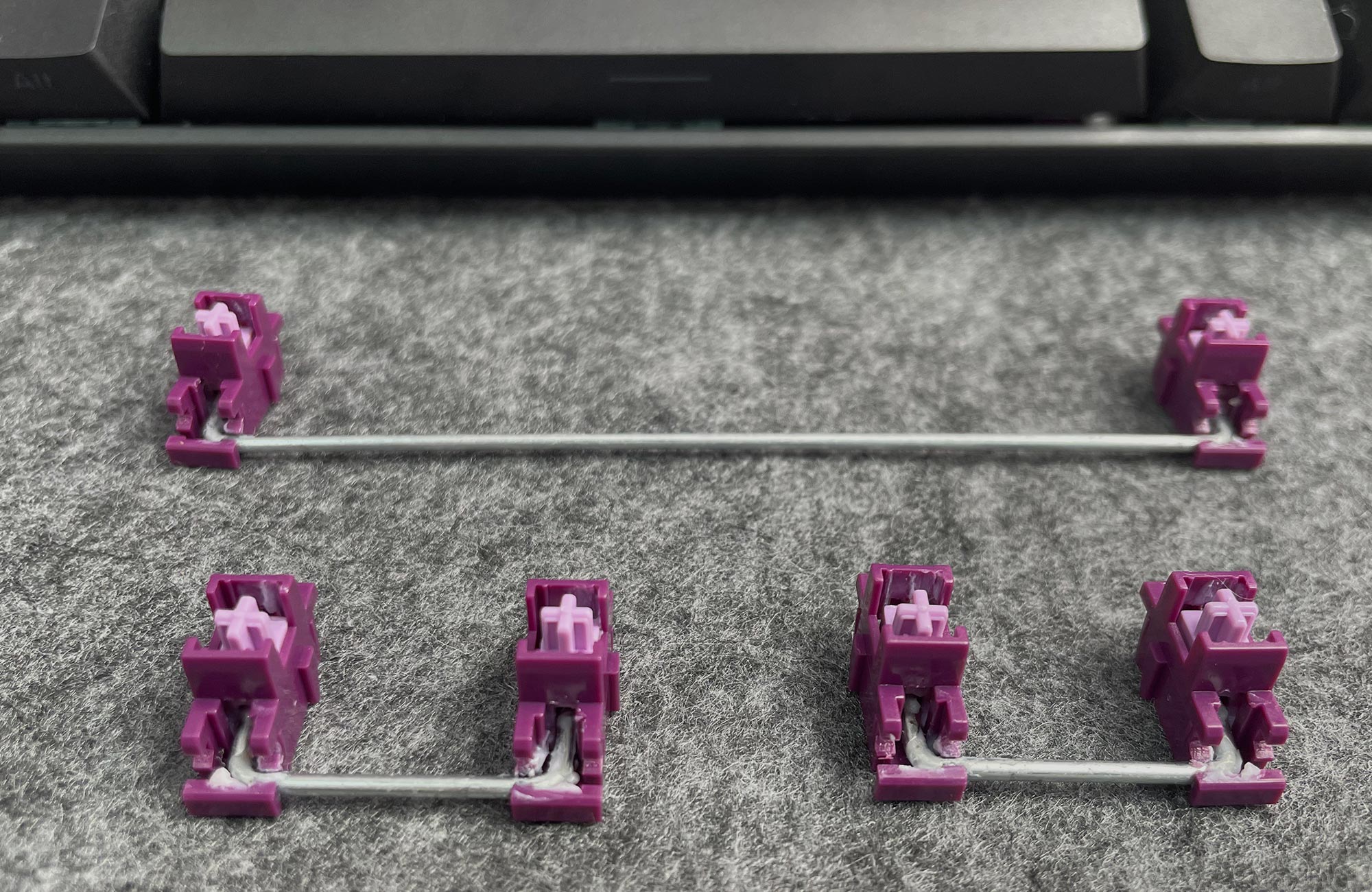
We think it’s crucial to be transparent about this.
What We’re Developing and How Users Can Enhance the Typing Experience?
✔ Screw-in Stabilizer in Consideration
Screw-in stabilizers may be helpful sound-wise and we are actively looking at this option as long as:
- It doesn’t cause interference with the existing case and TMR sensors
- The precision of 0.01mm remain solid on the PCB.
Based on the current data, thicker switch pad would also affect the accuracy of actuation. Hence we need to be super careful on this comparing to the time when we deal with 0.1mm precision. And we will continue to see if screw-in stabilizers are possible on FUN60.
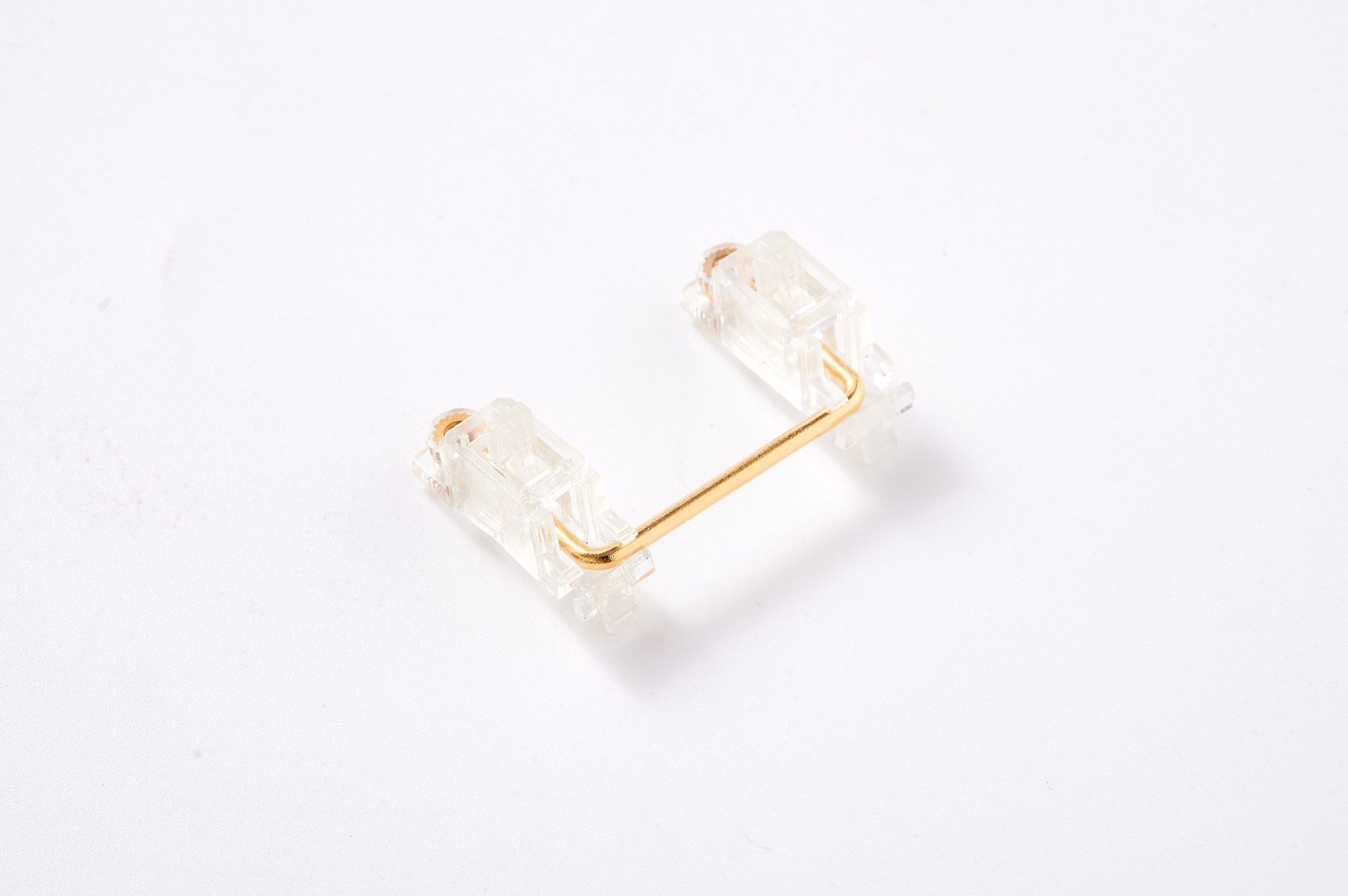
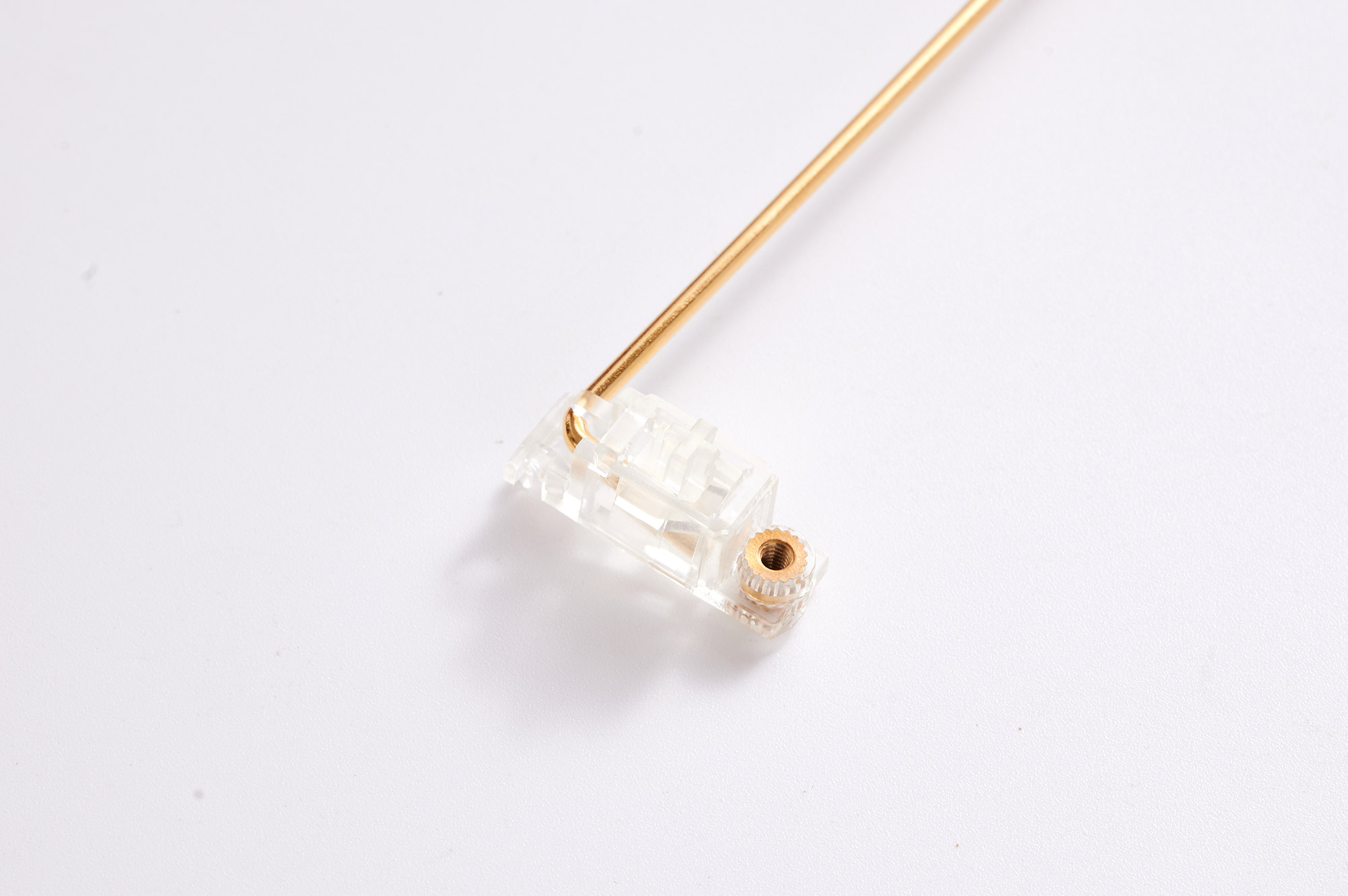
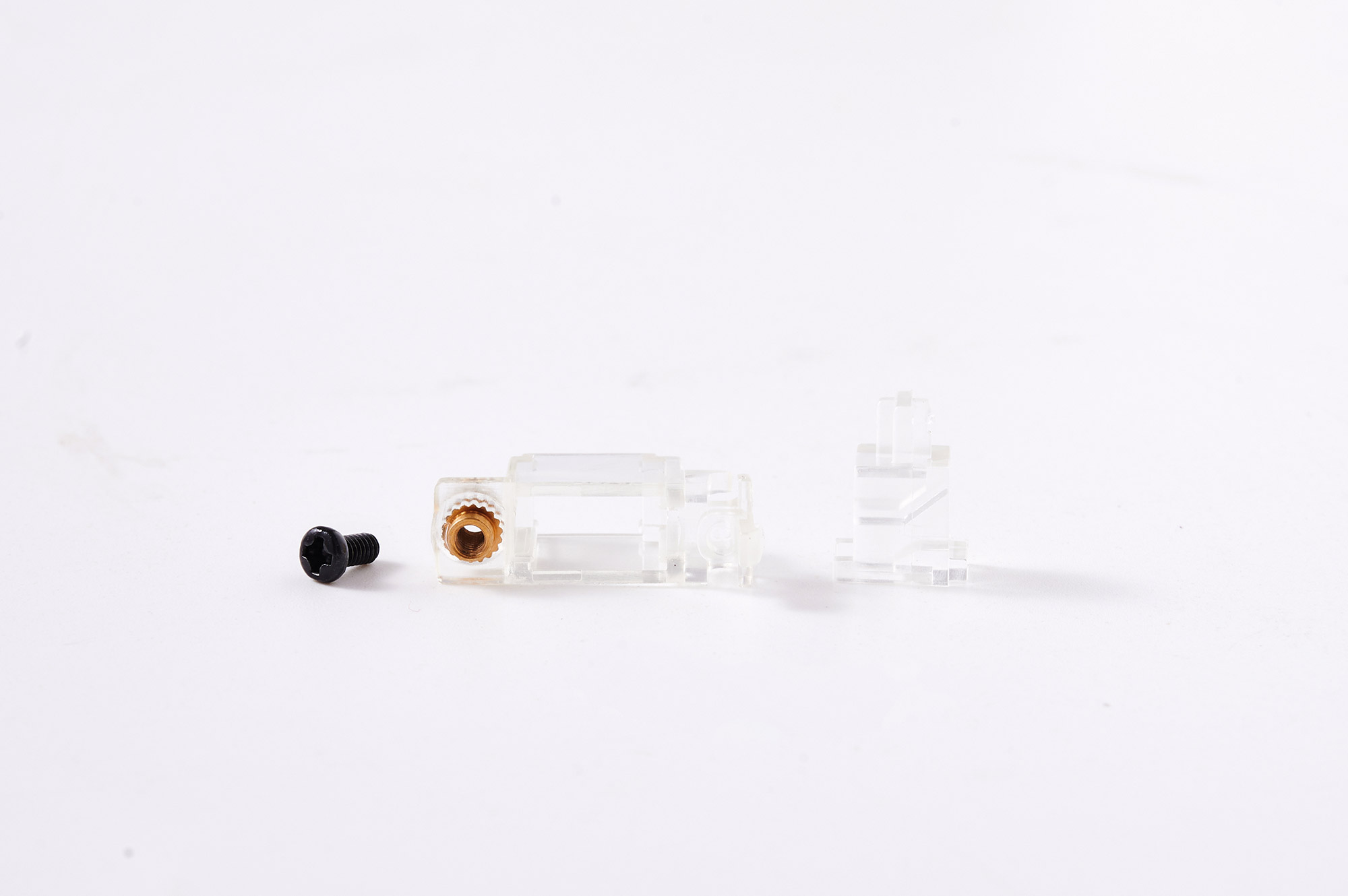
*Akko Screw-in Stabilizers
✔ Users can try using case foam or a mousepad for enhanced performance.
- For keyboard enthusiasts or community members looking to enhance their typing experience, we recommend adding a heavy silicone case foam to increase the keyboard’s weight.
- Additionally, using a mousepad on your desk can help improve the sound profile.
✔ What We Strive to Share and Do Better?
The FUN60 Pro version will start at $29.99, and we hope to deliver its full value at this price point.
For the Ultra version, made from CNC aluminum and supporting certain mechanical switch options, we’ll fine-tune the stabilizers to the best of our ability and enhance the magnetic switches for greater stability and reliability.
Thank you for your understanding and support.
How to choose between different FUN60 models?
📅Dec 14 2024
All upcoming models in the FUN60 Series—Pro, Max, and Ultra—come with Akko Glare magnetic switches and offer key features such as a universal 8K polling rate, Custom Actuation, Mod-Tap, Toggle Key, Dynamic Keystroke, Key Remapping, Customizable RGB, and SOCD. The main differences lie in multi-mode or mechanical switch support, TMR or Hall Effect sensors, and keycap options.
What’s the difference among FUN60 Series? The chart below highlights the key differences in the FUN60 series for a quick guide
Basically, there are a few rule of thumbs:
- All models have 8K Polling Rate in Wired Mode (except for basic 1K FUN60, which isn’t offered in global store)
- MAX/ULTRA version has 8K Polling Rate even in Wireless 2.4G Mode
- ULTRA version also comes with ALUMINUM cases
- ULTRA version has a TMR sensor variant that offers an additional feature called MagMech (compatible with both listed magnetic and any 5-pin mechanical switches)
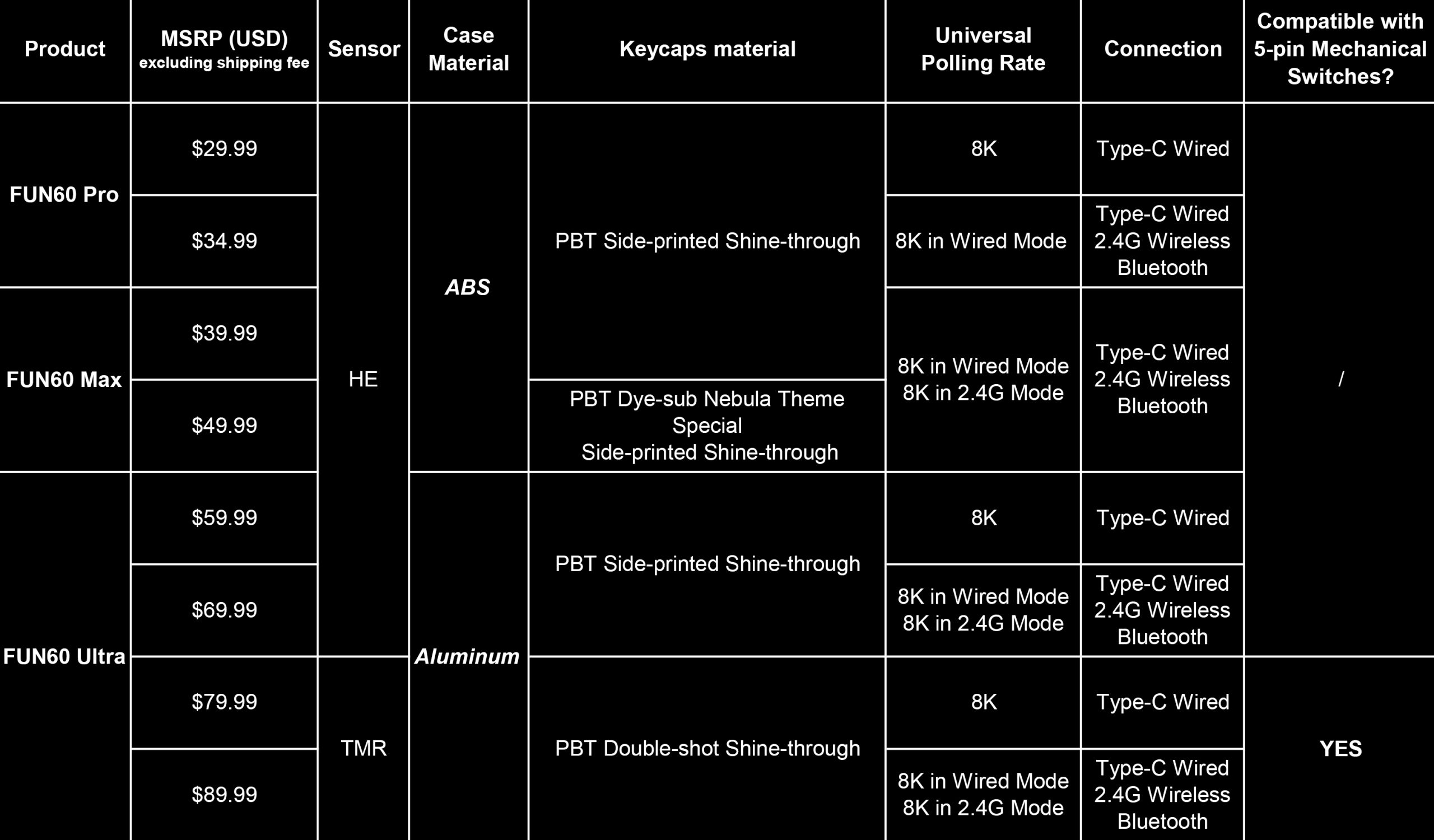
How to choose among them?
✔For Basic Elementary, choose the FUN60 Pro (USB-C Wired/Multi-mode), priced at just $29.99 and $34.99
✔ For Wireless Gamers, go for the FUN60 Max Multi-mode, priced at $39.99 and $49.99
✔ For those who need an Aluminum Keyboard but only want Magnetic Switches, opt for the FUN60 Ultra SP with Hall Effect Sensor(USB-C Wired/Multi-mode), priced at $59.99 and $69.99
✔ If Aluminum is a must, and compatibility with mechanical switches is desired, select the FUN60 Ultra with TMR Sensor(USB-C Wired/Multi-mode), priced at $79.99 and $89.99
Heads-Up of MonsGeek FUN60 Series Magnetic Switch Keyboard
📅Dec 13 2024
